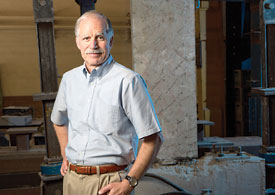Related stories:
What moment in the classroom or lab stands out as the most memorable?
Having a student tell me at the end of the semester how she really did not want to take this class, but actually ended up enjoying it because I made the topic interesting.
What can’t you live without?
My family, friends and colleagues.
What is your favorite spot on campus?
Standing in front of the Rackham building a gazing south toward the Graduate Library.
What inspires you?
The students.
What are you currently reading?
I just finished John Grisham’s new book, “Calico Joe.”
Who had the greatest influence on your career path?
My thesis adviser, Professor Mete Sozen at the University of Illinois, and my structural engineering professor at Michigan State, Professor James Lubkin.
Stepping behind the Iron Curtain after the 1988 Spitak earthquake, James Wight, professor of civil and environmental engineering, was struck by the staggering damage.
“When we talked to them, even the Armenians realized the designs they were using weren’t adequate but they had been dictated from above so they had to follow them,” says Wight, who traveled to Armenia to study the aftermath of the earthquake and the building damage.
In addition to Armenia, Wight has traveled to Mexico, Chile, India and Japan several times. “After a major earthquake in the world, if there were modern buildings damaged, the National Science Foundation sends out investigators to take measurements of structural dimensions and material properties, as well as take photographs to document the overall damage and distortion that has occurred to structures during the earthquake,” says Wight, who usually spends a week in the locations.
Utilizing the data he collects after earthquakes, Wight returns to U-M to study the problems with the damaged structure. “The primary result is hopefully an improvement in the building codes that we use in the United States. We want to point out a potential flaw and change it in the building codes,” says Wight, the current president of the American Concrete Institute.
Over his 39-year career, Wight continues to share the experiences he has had in various countries with his students by emphasizing the importance of a building’s structure. “I teach all the undergraduate and graduate courses on design of reinforced concrete structures. In the graduate courses I try to get the students thinking more about energy released by the earthquake and how the buildings can absorb the energy, keep occupants safe and not crumble under stress,” Wight says.

Photo by Austin Thomason, Michigan Photography.
Along with teaching, Wight also conducts research at U-M, studying how to design a concrete building that resists the affects of an earthquake. “We have a large lab that is big enough for us to apply loads to components of a structure. So we’ll bolt different connections, beams or columns down and we’ll subject them to displacements and forces they might experience during an earthquake,” he says.
Constantly experimenting, Wight hopes to continue to further developments in the study of the damage an earthquake causes. “We keep learning from nature,” he says. “I think, though, we’ve progressed to the point that relatively small earthquakes can be survived without much damage.”
Looking into the future, Wight’s has shifted focus as the new sustainability movement becomes a forefront issue. “We as a profession have become much more aware of trying to coordinate with energy resources, being more careful with the use of material so that we don’t harm the environment while constructing structures. It’s becoming more of a theme in an educational system like U-M,” Wight says.
The weekly Spotlight features faculty and staff members at the university. To nominate a candidate, please contact the Record staff at [email protected].

